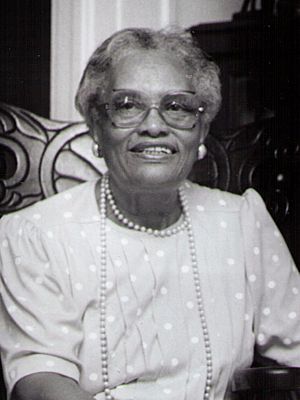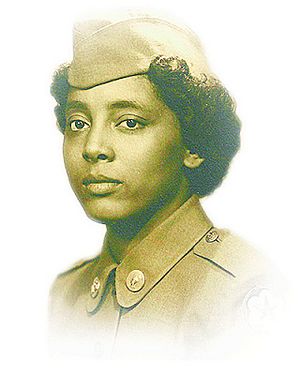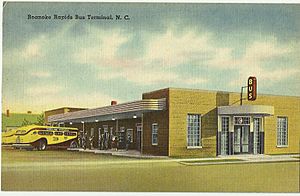Keys v. Carolina Coach Co. facts for kids
Sarah Keys v. Carolina Coach Company was a very important civil rights case in the United States. In 1955, a government group called the Interstate Commerce Commission (ICC) made a big decision. They said it was against the law to separate Black passengers from white passengers on buses that traveled between states. This decision was a huge step away from the old "separate but equal" rule that had been in place for many years.
The case started because of a complaint in 1953 by a young soldier named Sarah Louise Keys. She was a private in the Women's Army Corps (WAC). Her lawyers, Julius Winfield Robertson and Dovey Johnson Roundtree, worked hard on the case. Dovey Roundtree had also experienced unfair bus travel, so this case was very personal for her.
The ruling in November 1955 was announced just six days before Rosa Parks famously refused to give up her seat on a bus in Montgomery, Alabama. The Keys case used the ideas from another important Supreme Court case, Brown v. Board of Education, which had ended segregation in schools. For the first time, these ideas were applied to buses traveling across state lines. This closed a loophole that bus companies had used to keep segregation rules. The Keys v. Carolina Coach ruling was the only time a court or federal group clearly rejected the "Plessy v. Ferguson" rule for bus travel between states.
This ruling made history again in 1961. That's when Attorney General Robert F. Kennedy used it to help end unfair travel rules during the Freedom Riders' protests.
Contents
What Happened to Sarah Keys?
The Keys case began with an incident in Roanoke Rapids, North Carolina, just after midnight on August 1, 1952. Sarah Keys, an African American soldier, was traveling home on leave. A bus driver forced her to give up her seat at the front of the bus to a white Marine.
At that time, "Jim Crow laws" controlled bus travel in the Southern states. These laws made Black and white people use separate facilities. Even though the Supreme Court had tried to stop this in 1946 with the Morgan v. Virginia decision, Southern bus companies found ways around it. They made their own segregation rules. Also, the government group that regulated bus companies, the Interstate Commerce Commission, allowed separate areas for different races as long as they seemed "equal."
When Sarah Keys left her army post in New Jersey, she boarded a bus where everyone could sit together. She changed buses in Washington, D.C. and took a seat near the front of a Carolina Trailways bus. When the bus stopped in Roanoke Rapids, a new driver got on. He told Sarah she had to move to the "colored section" at the back of the bus. He wanted a white Marine to have her seat.
Sarah Keys refused to move. So, the driver made everyone else get off the bus and board a different one. He would not let Sarah get on the new bus. An argument happened, and Sarah was arrested. She was accused of causing trouble, put in jail overnight, and then fined $25.
The Fight for Justice

Sarah Keys and her father did not accept the court's decision. They went to the National Association for the Advancement of Colored People (NAACP) office in Washington, D.C. The NAACP sent Sarah's case to Dovey Johnson Roundtree. Dovey had also served in the Women's Army Corps (WAC) and understood Sarah's experience. In 1943, Dovey herself had been forced off a bus in Florida in a similar situation.
Dovey and her law partner, Julius Winfield Robertson, took on the case. They had learned from famous civil rights lawyers like Thurgood Marshall. Dovey later wrote that she felt a strong connection with Sarah, as if she was "looking in a mirror."
The timing of the case was important. It happened at the same time the Supreme Court was hearing arguments for the famous school segregation case, Brown v. Board of Education. When a lower court dismissed the Keys case in 1953, Dovey and Robertson decided to take it to the Interstate Commerce Commission (ICC). They hoped the ICC would change its old rules, just as the Supreme Court was rethinking its rules about the Fourteenth Amendment.
On September 1, 1953, Sarah Keys became the first Black person to complain to the ICC about unfair bus segregation.
A Historic Decision
When the Supreme Court made its big ruling in Brown v. Board of Education on May 17, 1954, the ICC first ignored it. An ICC examiner said that Brown had nothing to do with private bus companies. He used old rules to say that segregation was allowed.
Dovey Roundtree reached out to Congressman Adam Clayton Powell. She asked him to protest the ruling and demand a new hearing. Because of his help, a new hearing was granted. Dovey and Robertson then argued that segregation on buses was against the commerce clause of the U.S. Constitution and the ideas from the Brown case.
On November 7, 1955, the ICC made a historic decision. In the Keys case, and a similar case about train segregation, the ICC ruled that the Interstate Commerce Act itself made segregation illegal. The Keys decision was made public just one week before Rosa Parks' famous protest. It said that making Black travelers sit in certain parts of buses was unfair and made them feel less important.
The ruling stated: "We conclude that the assignment of seats on interstate buses, so designed as to imply the inherent inferiority of a traveler solely because of race or color, must be regarded as subjecting the traveler to unjust discrimination... We find that the practice of defendant requiring that Negro interstate passengers occupy space or seats in specified portions of its buses, subjects such passengers to unjust discrimination... and is therefore unlawful."
Making the Rules Stick
The press called the Keys case a "symbol of a movement that cannot be held back." It was a major change in the fight against segregation. However, for a while, the ruling wasn't fully put into action. One ICC commissioner, J. Monroe Johnson, disagreed with the decision and didn't enforce it.
It wasn't until the summer of 1961 that the Keys case truly made an impact. This was when the Freedom Riders protests led to violence. Attorney General Robert F. Kennedy then stepped in.
Kennedy asked the Interstate Commerce Commission to enforce its own rulings. He mentioned the Keys case and other rulings that banned segregation in travel. He asked the ICC to create specific rules to end Jim Crow in interstate travel and make sure they were followed right away.
Why This Case Matters
Keys v. Carolina Coach Company was a big step forward in the fight for civil rights. However, it is often overshadowed by later events, like Rosa Parks' protest and the Montgomery Bus Boycott. Parks' action led to a Supreme Court decision that banned segregation on buses within individual states. It also helped start the civil rights movement led by Rev. Martin Luther King Jr..
The protest movement led by King created a situation where rulings like Keys could finally be put into practice. So, the Keys case is one important piece in the complex fight for civil rights. Legal battles and activist protests worked together to help end Jim Crow laws.
Images for kids
-
Carolina Trailways Bus Station in Roanoke Rapids, North Carolina, shown in an old postcard.
-
Sarah Keys' lawyer, Dovey Johnson Roundtree, in a 1994 photo.






